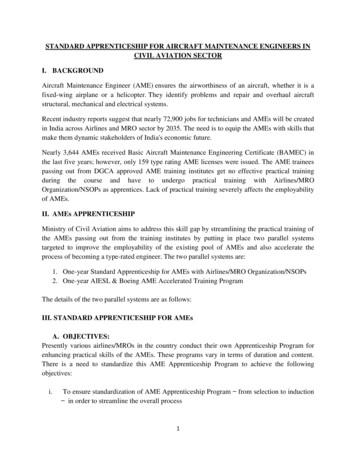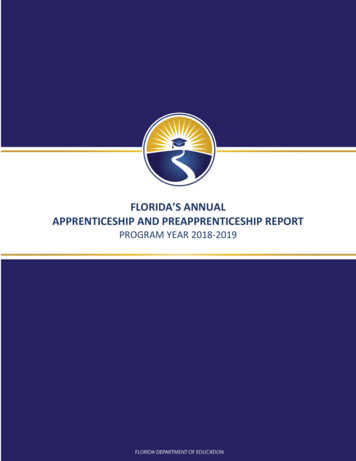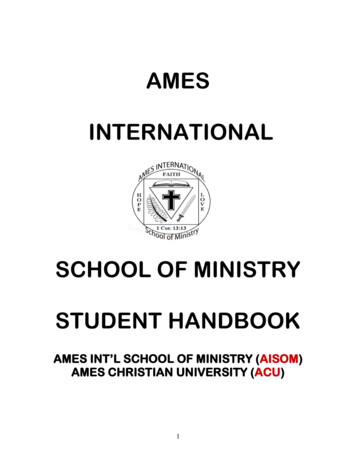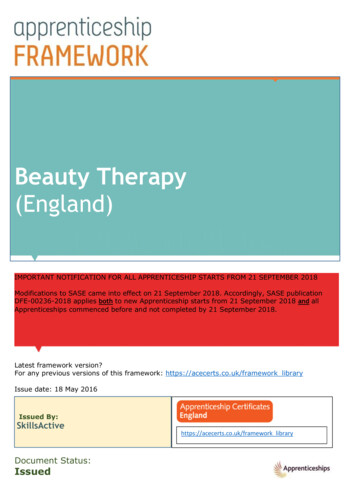
Transcription
STANDARD APPRENTICESHIP FOR AIRCRAFT MAINTENANCE ENGINEERS INCIVIL AVIATION SECTORI. BACKGROUNDAircraft Maintenance Engineer (AME) ensures the airworthiness of an aircraft, whether it is afixed-wing airplane or a helicopter. They identify problems and repair and overhaul aircraftstructural, mechanical and electrical systems.Recent industry reports suggest that nearly 72,900 jobs for technicians and AMEs will be createdin India across Airlines and MRO sector by 2035. The need is to equip the AMEs with skills thatmake them dynamic stakeholders of India's economic future.Nearly 3,644 AMEs received Basic Aircraft Maintenance Engineering Certificate (BAMEC) inthe last five years; however, only 159 type rating AME licenses were issued. The AME traineespassing out from DGCA approved AME training institutes get no effective practical trainingduring the course and have to undergo practical training with Airlines/MROOrganization/NSOPs as apprentices. Lack of practical training severely affects the employabilityof AMEs.II. AMEs APPRENTICESHIPMinistry of Civil Aviation aims to address this skill gap by streamlining the practical training ofthe AMEs passing out from the training institutes by putting in place two parallel systemstargeted to improve the employability of the existing pool of AMEs and also accelerate theprocess of becoming a type-rated engineer. The two parallel systems are:1. One-year Standard Apprenticeship for AMEs with Airlines/MRO Organization/NSOPs2. One-year AIESL & Boeing AME Accelerated Training ProgramThe details of the two parallel systems are as follows:III. STANDARD APPRENTICESHIP FOR AMEsA. OBJECTIVES:Presently various airlines/MROs in the country conduct their own Apprenticeship Program forenhancing practical skills of the AMEs. These programs vary in terms of duration and content.There is a need to standardize this AME Apprenticeship Program to achieve the followingobjectives:i.To ensure standardization of AME Apprenticeship Programin order to streamline the overall process1from selection to induction
ii.iii.Improve the employability of the students by providing them with needed skills and aCertificate of Competence recognized as a Certificate of Experience after standardizedsystem of assessments.Making the one-year Apprenticeship equivalent to one year of employment. (DGCAmandates four years of practical training on an operating Aircraft as eligibility conditionfor sitting for Category ‘A’ examination. Relaxation of one year is given to candidatespassing out from DGCA-approved AME training institutes). The Apprenticeship trainingwill be counted as a period of employment by DGCA and hence, will be an addedadvantage for candidates as once the candidate has completed his/her apprenticeship,he/she will be required to take employment for only two years to become eligible to sitfor the Category ‘A’ examination.The Standard Apprenticeship Modules (Appendix A & B) have been developed by a TechnicalCommittee headed by DDG, DGCA and included representatives from Airlines and Helicopters.B. SCOPE OF THE TRAININGThe Apprenticeship covers following streams:1. AME Mechanical Stream (Fixed Wing)2. AME Mechanical Stream (Helicopters)3. AME Avionics StreamThe Training will be applicable for all Airlines, MRO Organizations, NSOPs and CAR 145Aircraft Maintenance Organizations (henceforth, known as employers) with more than 40employees. The employers are entitled to engage apprentices up to 25% of their manpower.C. ELIGIBILTIY CRITERIA, SELECTION PROCESS, PERIOD OF TRAINING,CONTENT, ASSESSEMENT, INDUCTION & MONITORING Eligibility CriteriaCandidates who have passed 3 year AME training Course from DGCA-approved AMEtraining institutes and have passed DGCA paper 1 and paper 2 or equivalent Modules,and have less than one year of experience shall be eligible for the AME ApprenticeshipTraining. Method of SelectionMoCA will develop an AME Apprenticeship Portal that will track and monitorimplementation of AME Apprenticeship training apart from the registration of candidatesand employers on the portal. Both the candidates and employers will register on theportal. The employers will indicate the number of apprentices they will train in aparticular year based on their existing and projected requirements. The number of2
apprentices trained should be more (at least half of the total number to be inducted) thanthe apprentices that the employers will induct after successful completion of theapprenticeship training. For example, if airlines wish to induct 30 apprentices aftercompletion of training then, desirably, they should train at least 45 apprentices, so thatthe rest 15 will at least have a Certificate of Competence which will be recognized acrossthe industry and help him/her gain employment with other employers.The AME Apprenticeship Portal will generate a merit list of all registered candidates thatwill be available to employers, who will conduct their own interviews/assessment tests toselect candidates from the master pool. Period of TrainingThe Apprenticeship training will be for a period of one year. ContentThe Standard Training Modules for Fixed Wing and Helicopters would be as attached atAppendix A and B, respectively.Classroom training will cover the knowledge requirement in certain areas which areconsidered prerequisites for the apprentices to work in maintenance environment like: AirLegislation and its application relevant to maintenance, documentation, Ramp andpersonal safety, Standard Maintenance Practices, Human Factors, Safety ManagementSystem, Organization Maintenance Capability and Scope of Approval, Fleet Aircraft andtheir System Overview, Aircraft Servicing Procedures and Precautions, etc.The Work Environment/ Field Training will be a guided program under the supervisionof permanent staff in the areas, such as, use of general tools and special tools, use ofpersonal safety equipments and items, maintenance precautions, understanding of rampmarkings and arrangements, aircraft receiving and dispatching procedures, aircraftinspection and servicing, use of aircraft auxiliary power supply equipment like GPU, A/Ccart, hydraulic cart, etc., aircraft component locations, identification, removal andinstallation procedures, aircraft cleaning, aircraft interior inspection and maintenance, etc.Field Training will be delivered by experienced staff functioning in Line and BaseMaintenance Departments. The Field Training will constitute 75% of theApprenticeship training.3
Assessment & CertificationAfter undergoing the one-year Apprenticeship, candidates will be assessed by therespective employers as per Chapter 5 of the Standard Apprenticeship Module. Basis thisassessment, employers will certify the selected candidates and employ those who meetthe mark. The others may seek employment with other Airlines/MRO with the certificateissued after successful completion of the Apprenticeship. Induction of trained ApprenticesThe employers will induct the Apprentices successfully completing Apprenticeship as pertheir performance and as per the number of vacancies posted by them on the website.D. STIPENDThe employers should pay a minimum stipend of Rs. 3542 to apprentices during the period ofapprenticeship training. The minimum stipend to be paid under this apprenticeship will bedeemed to be revised as and when the minimum stipend for technicians is revised under theApprenticeship Act, 1961. Employers are however; free to pay stipends higher than theminimum rate.E. INDEMNITYAll employers will indemnify the Apprentices selected in their organization through a suitableinsurance policy.IV. AME TRACKING & MONITORING PORTALi. MoCA will develop a Web Portal where the candidates will register by filling in theirdetails through a registration form. They would also be required to upload the necessarycertificates/mark sheets.ii. The list of registered candidates ranked on the basis of merit will be available on thewebsite for information of employers.iii. Employers will register and post their requirement for technicians at least 2 months priorto selection of apprentices. The system will generate a merit wise list of the registeredcandidates which will be available to them. The employers will then select theApprentices from the master pool through an interview/assessment for the apprenticeship.iv.The number of trained apprentices inducted by different employers along withapprentices not inducted after successful completion of training but awarded withCertificate of Competence would also be tracked.v. Overall, the Portal will track the performance of the AMEs registered on the website andalso monitor the implementation of the Standard Apprenticeship for AMEs.4
V. AIESL & BOEING AME ACCELERATED APPRENTICESHIP PROGRAMConsidering the importance of skilled aircraft maintenance engineers (AME) in a fast-growingaviation market like India, Boeing has taken the initiative to support Air India EngineeringServices Ltd. (AIESL) in developing the AME Accelerated Apprenticeship Program.The key objectives of the program are to improve the employability of AME college graduatesthrough training and hands-on experience with actual aircraft. Students completing AME coursefrom Directorate General of Civil Aviation (DGCA) approved AME institutes will be eligible toapply to the program. To be admitted, applicants must first perform well on an entranceexamination. The AME Accelerated Apprenticeship Program will consist of one year of theoryand practical learning in a smart-classroom environment, including select CAR66 modules.Students will also receive advanced training aids to help strengthen the theoretical conceptslearned in the classroom. These will be supplemented by performing specific tasks on Boeingaircraft. The first class will commence at the AIESL Mumbai facility in November 2017. At theend of the program, successful candidates will receive a certificate from AIESL. They will alsoreceive coaching on job interview skills to prepare them to find a job.Additional details about the program, such as scope, fees, and entrance examination, will beavailable soon.VI. RAJIV GANDHI NATIONAL AVIATION UNIVERSITYMoCA along with Rajiv Gandhi National Aviation University (RGNAU) is also proactivelyworking towards starting the affiliation of AME training institutes and other colleges for theUGC Approved B.Sc. (H) in Aircraft Maintenance Engineering degree course from the nextacademic session (2018-19). RGNAU will also develop Conversion Courses with skill testingmechanism that will enable conversion of Certificate of Completion from AME traininginstitutes to a degree.5
Recent industry reports suggest that nearly 72,900 jobs for technicians and AMEs will be created in India across Airlines and MRO sector by 2035. The need is to equip the AMEs with skills that make them dynamic stakeholders of India's economic future. Nearly 3,644 AMEs received Basic Aircraft Maintenance Engineering Certificate (BAMEC) in










